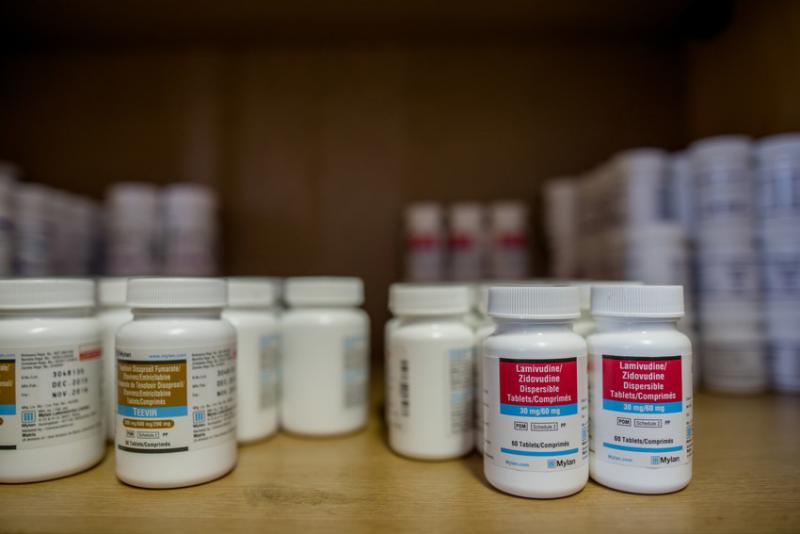Where We Work
See our interactive map


Namibia is close to reaching epidemic control, thanks in part to more widely available antiretroviral medications like these. Photo by Morgana Wingard for IntraHealth International.
There's been enormous progress here, but adolescent girls and young women still face particular risk.
Last month, I returned to Namibia for the first time in 12 years.
I lived here in 2005-2006 as a technical advisor to a large HIV/AIDS prevention program—a time when the epidemic was raging through Namibian communities. The prevalence rates were mindboggling, 24% in places such as Katima Mulilo. Although treatment was available, the services were not readily available or accessible.
It felt like we couldn’t inform and educate communities quickly enough or train enough health workers to counsel, test, and educate patients to meet the need. Messages were tested and retested to try and reach our target audiences.
I remember driving from town to town in the north and seeing graveyards where the small crosses that marked each grave started at the side of the road and disappeared into the distance.
The graveyards are still here, but they’re not expanding at the rate they were 10 years ago.
Twelve years later, I’ve returned to learn about our USAID Technical Assistance Project (UTAP), which is strengthening organizational and health worker capacity to deliver HIV services, both in the public sector and in facilities operated by nongovernmental organizations. Namibia has achieved enormous success since I was last here. It is hailed as one of the countries close to reaching epidemic control and there is pressure on government and all implementing partners to deliver more and to know the data in such detail that each and every person, their family members, and their sexual networks are tested and referred for treatment or other services, depending on the outcome of their tests.
I am up in the north of the country again for a quarterly review meeting. The graveyards are still here, but they’re not expanding at the rate they were 10 years ago and there’s an upbeat energy. Economically, things are bustling—shops and businesses line the side of roads and traffic like I don’t remember fills the main road that links the northern towns of Oshakati, Ondangwa, and Onandjokwe.
I sit through our team’s meeting and am impressed with the level of discussion and analysis around data, the challenges to reach targets, and the technical approaches the team has tried and tested to find people who live with HIV, start them on antiretroviral therapy (ART), and support their adherence to it.
However, it’s a conversation with the team’s communications manager that really catches my attention.
This is the generation of girls who were born with HIV and have been on treatment all their lives.
She recently traveled to a number of sites around the country to develop a success story on teen clubs that are helping HIV-positive girls adhere to their treatment and cope with adolescent issues that are exacerbated by living with HIV at such a young age.
This is the generation of girls who were born with HIV and have been on treatment all their lives. She tells me heartbreaking stories that she struggled to listen to.
Like the 13-year-old whose classmates found her ART pills in her school bag and tossed them around the classroom, publicly announcing that ‘she has beans’—beans is slang for ART meds. The shame and humiliation brought her to tears.
Or the 16-year-old who is angry at her parents for giving birth to her knowing that they were infected with HIV. The resentment of having to take medication for life. The overall fear, confusion and frustration of wanting a boyfriend and future dreams of marriage and a family. How to disclose her status to her peers without being rejected and treated differently.
I think of my own strong-willed, passionate, and ambitious 16-year-old daughter and what it would be like to tell her that she has HIV and will have to take medication for life without feeling like I’d failed her terribly. The arguments and pleading we’d have for her to take her medication daily. The difficult questions about how to think about her future in a positive light and creating a vision of success. The importance of being a role model of an adult who is living positively and managing the dynamics in a family where all or some members are HIV-positive. The stress of it all in a context of communities that are struggling economically, where violence against women and alcohol abuse are rampant.
It is in this reality that we cannot afford to lose sight of how vulnerable these young women are, and of their emotional and social needs. They continue to be the group most at risk of HIV infection, both through mother-to-child transmission and through older men who have sex with young girls. Through a new five-year award from the US Agency for International Development, we’ll be working together with Project Hope Namibia on the new DREAMS Activity to change this.
We’ve made incredible global progress toward eliminating AIDS as a public health threat. HIV-related deaths are down, and access to treatment is up. But while numbers, targets, and results are important, they cannot take priority over providing comprehensive services for those who need them most, including these adolescent girls in Namibia.
The need for support groups for young girls and parents is critical if countries are to reach epidemic control. The need for life skills, peer support, and understanding cannot be underestimated.
At the International AIDS Conference this week? Stop by booth 220 or come to one of our many sessions to learn more about IntraHealth’s work in Namibia and beyond to end the epidemic.
IntraHealth’s USAID HIV Clinical Services Technical Assistance Project in Namibia is funded by the US Agency for International Development (USAID) through the President’s Emergency Plan for AIDS Response (PEPFAR).
Get the latest updates from the blog and eNews




